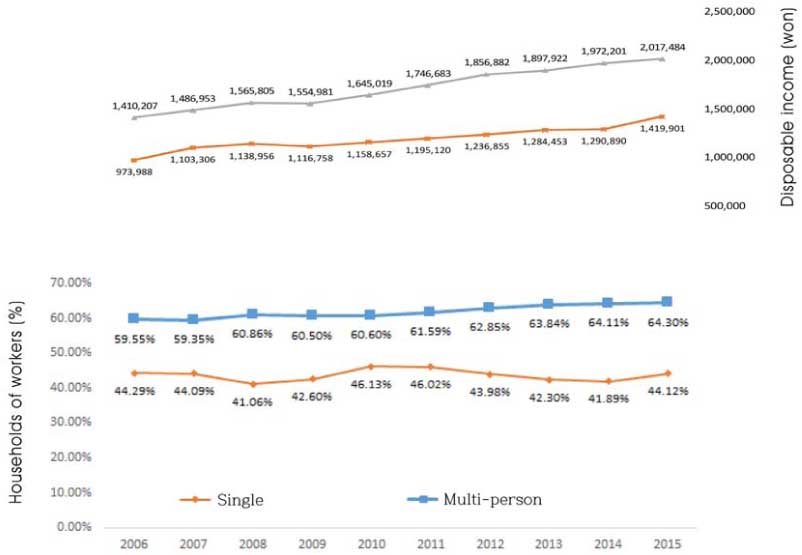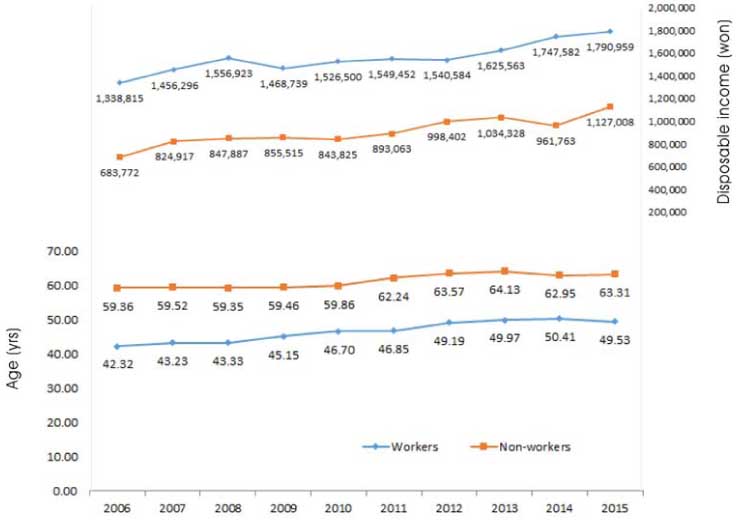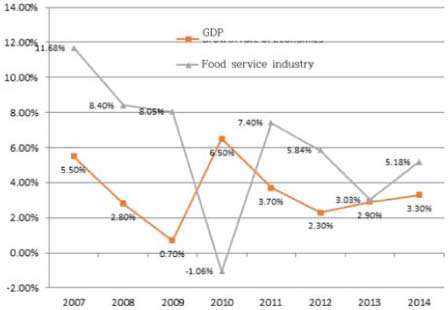Articles
- Page Path
- HOME > Korean J Community Nutr > Volume 21(4); 2016 > Article
-
Research Article
- The Effects of the Economic Characteristics of Single-person Households on the Food Service Industry
-
Pil Kyoo Jo

-
Korean Journal of Community Nutrition 2016;21(4):321-331.
DOI: https://doi.org/10.5720/kjcn.2016.21.4.321
Published online: August 31, 2016
Department of Economics, Hanbat National University, Daejeon, Korea.
- Corresponding author: Pil Kyoo Jo. Depatment of Economics, Hanbat National University, 125 Dongseo-daero, Yuseong-gu, Daejeon 34158, Korea. Tel: (042) 821-1767, Fax: (042) 821-1767, jopk@hanbat.ac.kr
Copyright © 2016 The Korean Society of Community Nutrition
This is an Open-Access article distributed under the terms of the Creative Commons Attribution Non-Commercial License (http://creativecommons.org/licenses/by-nc/3.0/) which permits unrestricted non-commercial use, distribution, and reproduction in any medium, provided the original work is properly cited.
- 1,076 Views
- 2 Download
- 14 Crossref
Figure & Data
REFERENCES
Citations

- Increasing single households challenges household decarbonization in Japan
Liqiao Huang, Yin Long, Zhiheng Chen, Yuan Li, Jiamin Ou, Yosuke Shigetomi, Yoshikuni Yoshida
Global Environmental Change.2024; 86: 102848. CrossRef - Selection of Dessert Cafes based on the Diverse Food-related Lifestyles of People Living in a Single-person Household
Hee-Jeong Yun, So-Yeon Jin
Journal of the East Asian Society of Dietary Life.2023; 33(3): 221. CrossRef - Service Opportunity Discovery Via Review Mining of Meal Kit Delivery Service
Jeayeon Jung, Jiho Lee, Janghyeok Yoon
Journal of the Korean Institute of Industrial Engineers.2023; 49(2): 142. CrossRef - Changes in food purchase, consumption and handling during COVID-19 pandemic among single person households
Janet Antwi, Yetunde Olawuyi, Shadiamon Bain, Kyndall Samuel, Charles Odilichukwu R. Okpala
PLOS ONE.2023; 18(11): e0294361. CrossRef - Effect of Household Type on the Prevalence of Climacteric Syndrome among Middle-Aged Men
Dohhee Kim, Seunghee Lee, Mijung Jang, KyooSang Kim
Healthcare.2023; 11(19): 2684. CrossRef - Association of the Healthy Eating Index with Metabolic Abnormalities among Middle-Aged Adults Living in Single-Person Households in Korea
Yun-Jung Bae, Kwang-Won Yu, Kyung-Haeng Lee, Keum-Il Jang
Nutrients.2021; 13(11): 3937. CrossRef - Association between the Frequency of Dining Out and the Risk of Obesity, Diabetes Mellitus, and Dyslipidemia among Korean Adults
Mi-Kyeong Choi, Yeon-Kyung Lee, Young-Ran Heo, Taisun Hyun, Eun-Soon Lyu, Haeryun Park, Hee-Kyong Ro, Yun Jung Bae
Ecology of Food and Nutrition.2019; 58(6): 560. CrossRef - Comparison of Dietary Behavior of Eating Alone in Single Households by Status of Workers and Age
Pil Kyoo Jo, Yu Jin Oh
Korean Journal of Community Nutrition.2019; 24(5): 408. CrossRef - Evaluation of the Nutrition Status and Metabolic Syndrome Prevalence of the Members according to the Number of Household Members based on the Korea National Health and Nutrition Examination Survey (2013–2014)
Jin-Young Lee, Soo-Kyong Choi, Jung-Sook Seo
Korean Journal of Community Nutrition.2019; 24(3): 232. CrossRef - Selection attributes of home meal replacement by food-related lifestyles of single-person households in South Korea
Soyeong Kim, Kiwon Lee, Youngmi Lee
Food Quality and Preference.2018; 66: 44. CrossRef - Food consumption behaviors of women by marital status: focus on the 2015 consumers survey data on food consumption behaviors
Eun-kyung Kim, Se-Young Ju
Journal of Nutrition and Health.2018; 51(2): 168. CrossRef - The Segmentation of Polish One-Person Households Due to Consumption
Marlena Piekut
Sustainability.2018; 11(1): 177. CrossRef - Energy intake from commercially-prepared meals by food source in Korean adults: Analysis of the 2001 and 2011 Korea National Health and Nutrition Examination Surveys
Injoo Choi, Won Gyoung Kim, Jihyun Yoon
Nutrition Research and Practice.2017; 11(2): 155. CrossRef - Meal Types by Cooking Method Consumed by Korean Adults according to Meal Provision Place: Using 2015 Korea National Health and Nutrition Examination Survey
Mi-Kyung Choi
Korean Journal of Food & Cookery Science.2017; 33(3): 264. CrossRef






Fig. 1
Fig. 2
Fig. 3
Fig. 4
Fig. 5
Fig. 6
Variables in models
Numbers of households, average age of head of household and rate of single households
Basic statistics of explanatory variables
1) Logarithm
Results of empirical study
Each model has dummy variables in 4 digits classification of industry
1) Coefficient (Standard error)
*: p < 0.05, **: p < 0.01
1) Logarithm
Each model has dummy variables in 4 digits classification of industry 1) Coefficient (Standard error) *: p < 0.05, **: p < 0.01

 KSCN
KSCN










 PubReader
PubReader Cite
Cite


